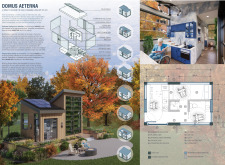5 key facts about this project
Sustainable Architectural Elements
The primary function of Domus Aeterna is to provide a resilient living space that adapts to the evolving requirements of its occupants. Architectural features include a modular layout, which allows for multifunctionality within open living spaces. The design incorporates large windows that maximize natural light and facilitate visual connections to the outdoor landscape. Native landscaping enhances the ecological footprint while promoting biodiversity and minimizing maintenance.
Key materials utilized in the construction include wood for structural elements and cladding, reinforcing warmth and durability. Double-glazed glass is employed throughout to enhance energy efficiency and create a seamless indoor-outdoor experience. The project also integrates solar panels into the roof structure, further reducing reliance on external energy sources. The incorporation of stormwater management systems ensures responsible water use, while composting solutions encourage sustainable waste practices.
Regenerative Design Approaches
What sets Domus Aeterna apart from typical residential projects is its explicit focus on regenerative design. This approach not only reduces environmental impact but aims to improve surrounding ecosystems. The architectural design includes features such as stormwater collection systems that allow for rainwater harvesting and reuse. These strategies illustrate a commitment to sustainability beyond energy conservation.
The accessibility of the design is another notable aspect. Wide entryways and adaptable interior layouts accommodate a diverse range of inhabitants, reinforcing the idea that homes should be inclusive. The approach ensures that all users, regardless of ability or age, can navigate and enjoy the space comfortably.
Exploring Architectural Details
To gain a comprehensive understanding of the Domus Aeterna project, readers are encouraged to review the architectural plans, sections, and designs. These detailed presentations illustrate the intricate aspects of the architectural ideas that inform both function and aesthetic. Analyzing these elements will provide deeper insights into how the project addresses complexity in urban living with a focus on sustainability, adaptability, and accessibility.























